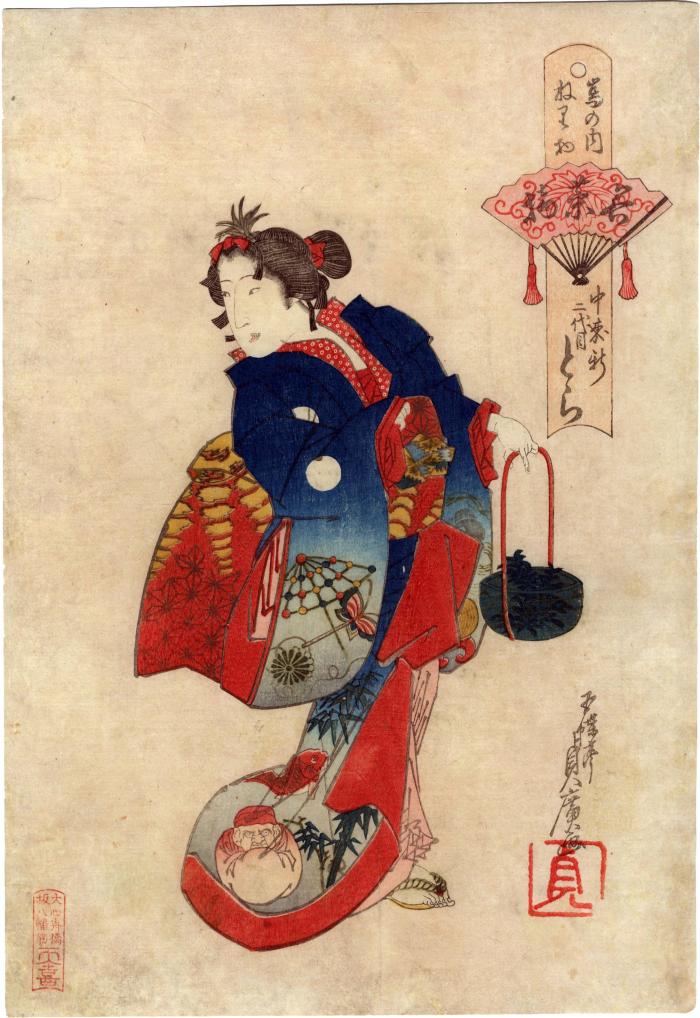Utagawa Sadahiro (歌川貞広) (artist )
Tora II (二代目とら) of Nakamoriken (中森軒) in Gathering Spring Herbs (Waka natsumi - 若菜摘) from the series Costume Parade of the Shimanouchi Quarter (Shimanouchi nerimono - 島之内ねり物)
06/1836
10 in x 14.5 in (Overall dimensions) Japanese woodblock print
Signed: Gochōtei Sadahiro ga
五蝶亭貞広画
Artist's seal: Sada
Publisher: Tenmaya Kihei
Musueum of Fine Arts, Boston
Rijksmuseum
Joseph Schnitzer Museum of Art
Museum of Fine Arts, Boston - Shigeharu prints from this series
Philadelphia Museum of Art - another similar Shigeharu print
Museum of Fine Arts, Boston - a Hokuju print from this series
Museum of Fine Arts, Boston - a Sadanobu print from this series
Museum of Fine Arts, Boston - a Hokuei print from this series
Hankyu Culture Foundation
Lyon Collection - another print from this series
Philadelphia Museum of Art - another copy of this print
Philadelphia Museum of Art - two related prints by Shigeharu The text in the upper right reads: 嶌のうち ねり物 若菜摘 中東新 二代目とら
In 1836 two publishers, Tenmaya Kihei and Honya Seishichi, got together with a group of artists, Hokuei, Shigeharu, Sadanobu, Hokuju and Sadahiro, to produce a series of 12 prints celebrating an annual festival in the Osaka Shimanouchi pleasure district. Each print shows a geisha in an elaborate costume. The title cartouche gives the name of the series, while the fan motif describes her costume and below that is the name of the woman posed and the establishment she worked for.
****
Illustrated:
1) in black and white in Hirosada: Ōsaka Printmaker by Roger Keyes, number 3, page 78 - the left-hand panel of a diptych. Published by the University Art Museum, California State University, Long Beach in 1984. Keyes dates it to 7/1837. This example comes from the collection of the Philadelphia Museum of Art. [He was mistaken about this being a diptych even though two prints are paired together. The series, by various artists, was made up of 12 prints.]
Keyes wrote: "The major kabuki and puppet theaters in Ōsaka were located in the Ebisu and Nihon Bridges along the south bank of the Doton Canal. Directly across the canal lay the Shimanouchi entertainment district, a congeries of restaurants and teahouses. The district sponsored annual events in which waitresses, geisha and other female entertainers donned elaborate costumes and performed skits or pantomimes. In 1836, the artist Hokuei designed a series of prints of these women in costume. The following year Hirosada designed pictures of two geisha employed by an establishment called Chūskinken (or Nakamoriken). The series title, the name of the woman and her place of employment are written on a cartouche int he shape of a wooden plaque, which supports a gan bearing the name of the woman's role. Matsuume is dressed as a maid (hashitame) carrying a football suspended from a leafy branch: Tora (the second woman to bear this name) carries a basket of freshly picked spring herbs. Sadanobu, Shigeharu and a pupil of Hokuei name Hokuju also contributed designs to the set."
2) in color in 原色浮世絵大百科事典 (Genshoku Ukiyoe Daihyakka Jiten), vol. 9, p. 128, #294.
3) in color in Ikeda Bunko, Kamigata yakusha-e shūsei (Collected Kamigata Actor Prints), vol. 3, Osaka, 2001, no. 93, p. 28.
4) in color in Schätze der Kamigata: Japanische Farbholzschnitte aus Osaka 1780-1880, MNHA (Musée national d'histoire et d'art Luxembourg), 2012, p. 99, #200.
5) in black and white in Ukiyo-e: Japanische Farbholzschnitte des 19. Jahrhunderts, Schenkung Dr. Hans Lühdorf. Bilder einer fließenden vergänglichen Welt., Kunstmuseum Düsseldorf im Ehrenhof, 1990, #353, page 187.
****
In The Theatrical World of Osaka Prints it says on pages 148-149:
"This pair [of Shigeharu] diptychs... is titled Shimanouchi Nerimono (Costumes in the Shimanouchi District"), which was published by Honsei and Tenki including prints by Sadahiro. Sadanobu, Hokuju, Hokuei, Yoshikuni, and others, showing female entertainers in costume for a parade in the Shimanouchi district of Osaka.This print is closely related to those illustrating the Noh play Kan'yō Kiyū ("The Kan'yō Palace) where a Chinese emperor and empress are threatened by assassins.
The official, government-controlled brothel district of Osaka was Shinmachi, but thirty or more smaller entertainment districts were scattered among the outskirts of the city in Horie, Tenma, Kitanoshinchi, Shimanouchi, and elsewhere. Shimanouchi was located just north of the Dōtonbori Canal from the theater district, and was the largest unofficial gay quarter in Osaka. One of the annual events of Shimanouchi was a parade each June with courtesans and geisha in masquerade. The parades were banned for some time, but resumed in the summer of 1819, and were made up of large floats carrying musicians and dancers. Festival programs [sairei banzuke] were issued to let people know the order of the floats and what each represented. The earliest Osaka prints of the subject were designed by Yanagawa Shigenobu and published around 1822, but Edo Prints, usually of large groups of figures were designed in the 1790s and earlier by Utamaro and others for the Niwaka festival in the Yoshiwara district there."
Tenmaya Kihei (天満屋喜兵衛) (publisher)
Historical - Social - Ephemera (genre)
Kyōto-Osaka prints (kamigata-e - 上方絵) (genre)
